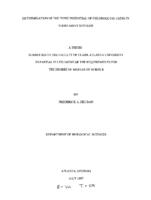- Collection:
- Atlanta University and Clark Atlanta University Theses and Dissertations
- Title:
- Determination of the toxic potnetial of chloroquine using in vitro assay systems, 1997
- Creator:
- Ekuban, Frederick A.
- Date of Original:
- 1997-07-01
- Subject:
- Degrees, Academic
Dissertations, Academic - Location:
- United States, Georgia, Fulton County, Atlanta, 33.749, -84.38798
- Medium:
- theses
- Type:
- Text
- Format:
- application/pdf
- Description:
- Chloroquine is a widely used antimicrobial and anti-inflammatory drug which exhibits toxicity towards microbes by preferential accumulation in the acidic digestive vacuole. It is known to inhibit both DNA and RNA polymerases, protein and lipid synthesis, and interferes with the excision repair mechanisms, however, its biochemical and cytotoxic mode of action is not clearly understood. The purpose of this investigation was to determine the cytotoxic, biochemical, and genotoxic effects of chloroquine on human host cells using AHH-1 lymphocytes as surrogate mammalian cells. Cells were grown in supplemented RPMI-1640 and exposed to serially diluted chloroquine concentrations ranging between 0 and 0.8 mM for 1 to 168 h. Cell proliferation was assessed by counting with a hemocytometer and viability was determined by the MTT and Acid Phosphatase assays. The distribution of viable, apoptotic and necrotic cells was determined by staining with propidium iodide and fluorescein diacetate and by using flow cytometry. Chromosomal aberration and membrane integrity were assessed by the micronucleus assay and cellular lactate dehydrogenase activity, respectively. Morphological characteristics were examined by electron microscopy. Chloroquine exposure (0.2 raM and 0.6 mM) caused an 80% decrease in cell counts after 24 h. The MTT assay showed a 58% to 94.5% viable cell loss at 0.2 mM and 0.6 mM, respectively, after 48 h treatment. Acid phosphatase activity increased 50% and 60% at 0.4 mM and 0.6 mM dosages, respectively, after 24 h, and declined 33% after 48 h. Flow cytometric analysis showed a 22% decrease in viable cell numbers, 17% increase in the apoptotic cell population, and a 5-fold increase in necrotic cell numbers showed, after 24 h of exposure. Although, cell cycling progression was not affected, a dose-dependent increase of 5% at 0.8 mM was observed for micronucleus formation. Lactate dehydrogenase activity levels peaked in the growth media at 0.3 mM, after 72 h exposure compared to the control. The electron microscopic analysis showed evidence of increased vacuolization, multilamellar body formation and membrane disruption with premature cell lysis. These studies suggest that chloroquine is cytotoxic to AHH-1 cells at physiologically relevant doses in vitro.
- External Identifiers:
- Metadata URL:
- http://hdl.handle.net/20.500.12322/cau.td:1997_ekuban_frederick_a
- Rights Holder:
- Clark Atlanta University
- Holding Institution:
- Atlanta University Center Robert W. Woodruff Library
- Rights:
-
